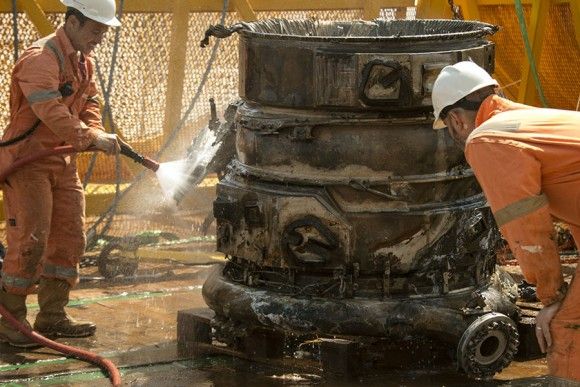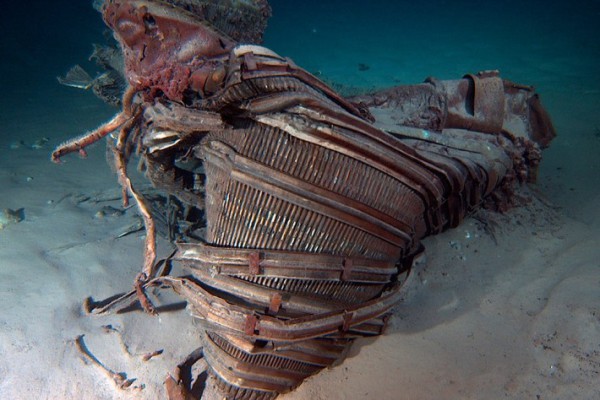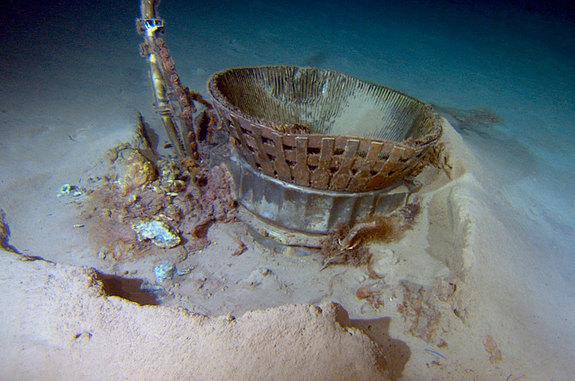On 15th March 2014, Buzz Aldrin presented Jeff Bezos, the CEO of Amazon.com, with the Citation of Merit award at the annual Explorer’s Club dinner. The award was granted for finding, raising and conserving engines from the Saturn rockets used to power Apollo missions into space. This award was the culmination of a long, dangerous, expensive, and highly complex project undertaken and funded by the Bezos Foundation.
In March 2012, the world was stunned when Bezos announced that his team of underwater explorers had found the long lost Saturn F-1 engines. Then a year later Bezos once again amazed the scientific community by disclosing that his team had in fact raised several other rocket parts off the sea floor.
When the Apollo missions blasted off into space they were launched out of earth’s gravitational pull by five huge Rocketdyne F-1 engines that were attached to the first stage. The engines were positioned with one at each corner of a square with the fifth in the middle. The middle engine was fixed in place but the other four could be hydraulically turned to steer the rocket. They accelerated the Saturn V rocket to a speed of 6,000 miles an hour. After pushing their precious cargo upwards for some 40 nautical miles, the rockets were blasted free of the second stage. They then fell back to earth, smashing into the Atlantic Ocean and dropping to the sea floor, where they lay undisturbed until the Bezos team managed to shine the light of day onto them once more.
The Bezos team was at sea for nearly a month; during that time they managed to raise parts from a depth of three miles. This was a formidable task as all the work was done using ROVs (remotely operated vehicles). The job of attaching a sling safely around delicate parts and then raising them to the surface through currents and wave action was, in itself, a remarkable achievement. It must have been otherworldly to suddenly see these massive, magnificent examples of human ingenuity lying in an environment eerily similar to that found on the moon. The desolation of the sea floor and the companionship of deep sea fishes seems an unlikely resting place for engines that helped to place a man on the moon, one of the greatest achievements that mankind has ever made. (Collect Space)
Once the parts were safely on the deck, the task of identifying them began. As Jim Remar, the COO of the Cosmosphere International SciEd Center and Space Museum, explained, “We were able to identify part numbers and serial numbers as we got deeper into the treatment process. There was a stencil painted onto one of the Apollo 12 thrust chambers that was still visible, so we were able to identify that via the stencil. Other components were discerned by finding the part or serial number.” Through this process the conservation team found a thrust chamber, a liquid oxygen dome and injector plate, a turbo pump and a heat exchanger from Apollo 11, two thrust chambers and a liquid oxygen dome from Apollo 12, and a heat exchanger, a turbine, and a manifold from Apollo 16, and thrust chambers from Apollo 13.

The energy with which the engines slammed into the water caused a significant amount of damage to the engines. One would think that engines designed to be subjected to the forces of a rocket launch would be recovered intact, but this proved not to be the case. The team raised 25,000 pounds of engine parts and delivered them to the conservation facility at Cosmosphere Center. They were placed in large wooden tanks so that they could be sprayed with fresh water and anti-corrosion chemicals. The large parts were sprayed with a corrosion inhibitor while the smaller parts were cleaned by hand. The artefacts were then carefully taken apart where possible, cleaned and then sprayed with sealant.
The engines were not restored in any way. The aim of the team was to display the engines in as close a condition as they were when retrieved from the sea floor. The team felt that to respect the history of the engines meant that not only were they pristine and new when they left on their one and only journey, they also spent forty years at the bottom of the sea – all of this history had to be reflected in their display. Though the engines are dented and look a little worse for wear, it is a testament to their original quality of construction that they are not simply lumps of metal but are still recognizable as engines or parts of engines today. The conservation team is working with NASA on how the artefacts will be displayed. While these engines were recovered and conserved privately, they do still remain the property of NASA.

It is remarkable that engines that fired astronauts Neil Armstong, Buzz Aldrin, and Michael Collins off into space and set them on their course for the moon have been found and will be carefully conserved for future generations. How many boys and girls will stand and gaze in awe at these nine- foot tall monsters and dream of one day flying into the unknown, emulating the brave men inside capsules that once sat atop these behemoths?
The Apollo 11 engines will form part of a display at the Smithsonian in 2019, the 50th anniversary of that historic mission. In the meantime they will be on display at Cosmosphere International SciEd Center and Space Museum in Kentucky.
